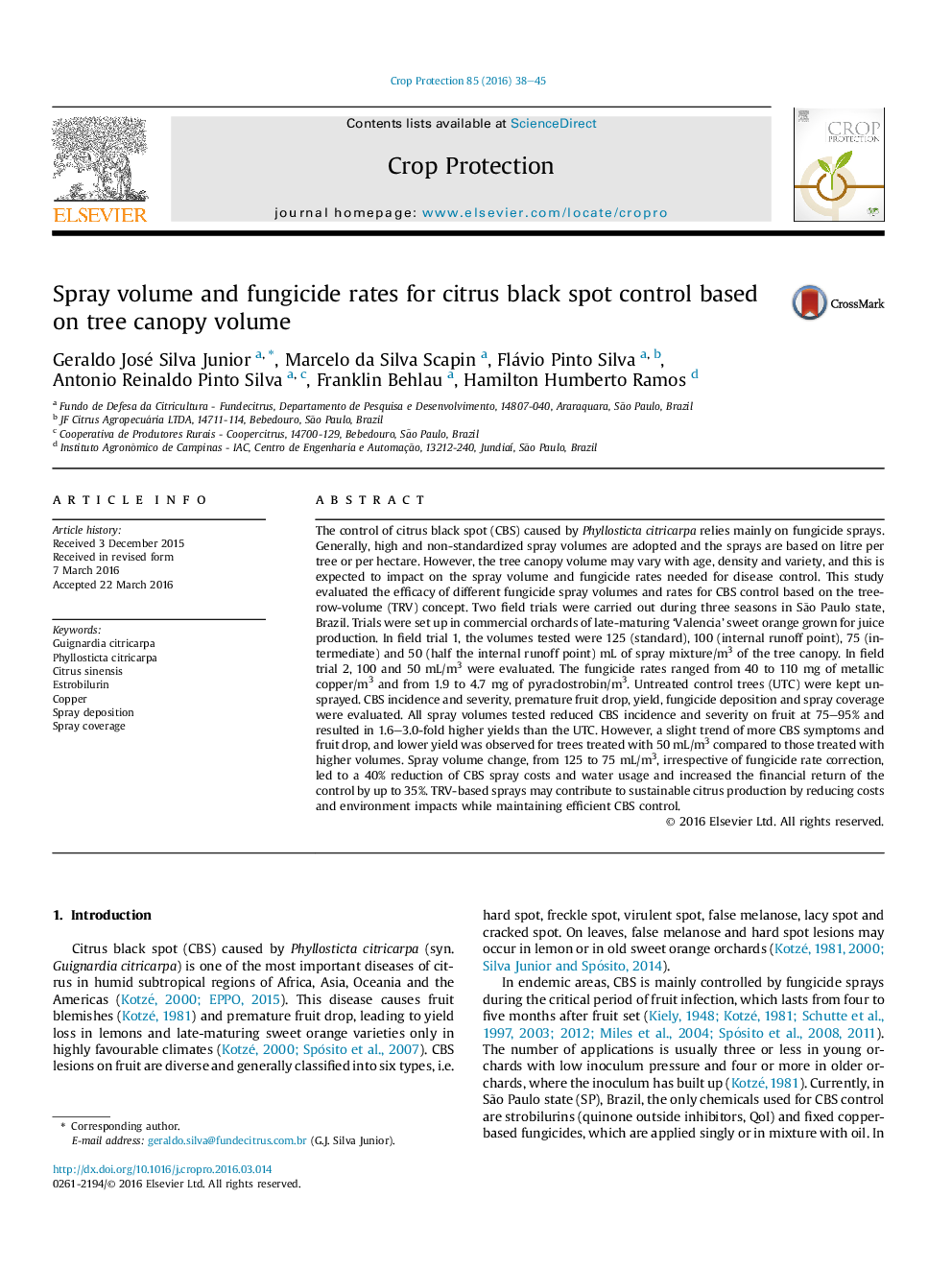| کد مقاله | کد نشریه | سال انتشار | مقاله انگلیسی | نسخه تمام متن |
|---|---|---|---|---|
| 6373300 | 1624302 | 2016 | 8 صفحه PDF | دانلود رایگان |
عنوان انگلیسی مقاله ISI
Spray volume and fungicide rates for citrus black spot control based on tree canopy volume
ترجمه فارسی عنوان
حجم اسپری و میزان قارچ کش برای کنترل نقطه سیاه مرکبات بر اساس حجم سایبان درخت
دانلود مقاله + سفارش ترجمه
دانلود مقاله ISI انگلیسی
رایگان برای ایرانیان
کلمات کلیدی
موضوعات مرتبط
علوم زیستی و بیوفناوری
علوم کشاورزی و بیولوژیک
علوم زراعت و اصلاح نباتات
چکیده انگلیسی
The control of citrus black spot (CBS) caused by Phyllosticta citricarpa relies mainly on fungicide sprays. Generally, high and non-standardized spray volumes are adopted and the sprays are based on litre per tree or per hectare. However, the tree canopy volume may vary with age, density and variety, and this is expected to impact on the spray volume and fungicide rates needed for disease control. This study evaluated the efficacy of different fungicide spray volumes and rates for CBS control based on the tree-row-volume (TRV) concept. Two field trials were carried out during three seasons in São Paulo state, Brazil. Trials were set up in commercial orchards of late-maturing 'Valencia' sweet orange grown for juice production. In field trial 1, the volumes tested were 125 (standard), 100 (internal runoff point), 75 (intermediate) and 50 (half the internal runoff point) mL of spray mixture/m3 of the tree canopy. In field trial 2, 100 and 50 mL/m3 were evaluated. The fungicide rates ranged from 40 to 110 mg of metallic copper/m3 and from 1.9 to 4.7 mg of pyraclostrobin/m3. Untreated control trees (UTC) were kept unsprayed. CBS incidence and severity, premature fruit drop, yield, fungicide deposition and spray coverage were evaluated. All spray volumes tested reduced CBS incidence and severity on fruit at 75-95% and resulted in 1.6-3.0-fold higher yields than the UTC. However, a slight trend of more CBS symptoms and fruit drop, and lower yield was observed for trees treated with 50 mL/m3 compared to those treated with higher volumes. Spray volume change, from 125 to 75 mL/m3, irrespective of fungicide rate correction, led to a 40% reduction of CBS spray costs and water usage and increased the financial return of the control by up to 35%. TRV-based sprays may contribute to sustainable citrus production by reducing costs and environment impacts while maintaining efficient CBS control.
ناشر
Database: Elsevier - ScienceDirect (ساینس دایرکت)
Journal: Crop Protection - Volume 85, July 2016, Pages 38-45
Journal: Crop Protection - Volume 85, July 2016, Pages 38-45
نویسندگان
Geraldo José Silva Junior, Marcelo da Silva Scapin, Flávio Pinto Silva, Antonio Reinaldo Pinto Silva, Franklin Behlau, Hamilton Humberto Ramos,
